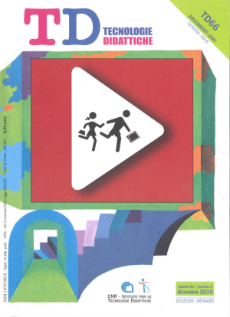MWS-WEB: a system to support a pedagogical approach based on the concept of multiliteracies
Main Article Content
Abstract
Article Details
Authors who publish with this journal agree to the following terms:
- Authors retain copyright and grant the journal right of first publication with the work simultaneously licensed under a Creative Commons CC BY 4.0 Attribution 4.0 International License.
- Authors are able to enter into separate, additional contractual arrangements for the non-exclusive distribution of the journal's published version of the work (e.g., post it to an institutional repository or publish it in a book), with an acknowledgement of its initial publication in this journal.
- Authors are permitted and encouraged to post their work online (e.g., in institutional repositories or on their website) prior to and during the submission process, as it can lead to productive exchanges, as well as earlier and greater citation of published work (See The Effect of Open Access)
References
Agudo-Peregrina, A.F., Iglesias-Pradas, S., Conde-González, M.A., & Hernández-García, A. (2014). Can we predict success from log data in VLEs? Classification of interactions for learning analytics and their relation with performance in VLE-supported F2F and online learning. Computers in Human Behavior, 31, 542-550. doi: dx.doi.org/10.1016/j.chb.2013.05.031
Baldry, A.P. (2010). A web-as-multimodal corpus approach to lexical studies based on intercultural and scalar principles. In M.M. Jaén, F.S. Valverde, & M.C. Pérez (Eds.), Exploring New Paths in Language Pedagogy. Lexis and Corpus Based Language Teaching (pp.173-190). London, UK: Equinox.
Baldry, A.P. (2011). Multimodal Web Genres: Exploring Scientific English. Como, IT: Ibis.
Baldry, A.P. (2012). Medical CLIL (Part 1): How a medical degree works. In M. Cambria, C. Arizzi, & F. Coccetta, (Eds.), Web Genres and Web Tools. Contributions from the Living Knowledge Project (pp.357-368). Como-Pavia, IT: Ibis.
Baldry, A.P., Gaggia, A., & Porta, M. (2011). Multimodal web concordancing and annotation. An overview of the MCAWEB System. In N. Vasta, A. Riem, M. Bortoluzzi, & S. Deborah (Eds.), Identities in Transition in the English-Speaking World (pp.39–60). Udine, IT: Forum Editrice.
Brown, J. S. (2002). Learning in the digital age. In M. Devlin, R. Larson,J. Meyerson (Eds.), The Internet & the University: Forum 2001 (pp. 65-91). Retrieved from http://www.johnseelybrown.com /learning_in_digital_age-aspen.pdf
Cazden, C., Cope, B., Fairclough, N., Gee, J., Kalantzis, M., Kress, G., … Nakata, M. [New London Group] (1996). A pedagogy of multiliteracies: designing social futures. Harvard Educational Review, 66(1), 60-92. Retrieved from http://www.sfu.ca/~decaste/newlondon.htm
Cope, B., & Kalantzis, M. (2009). Multiliteracies: new literacies, new learning. Pedagogies: An International Journal, 4(3), 164-195. doi:10.1080/15544800903076044
Cowie, B., & Bell, B. (1999). A model of formative assessment in science education. Assessment in Education: Principles, Policy and Practice, 6(1), 32-42.
Donnelly, R. (2010) Interaction analysis in a “learning by doing” problem-based professional development context, Computers & Education, 55(3), 1357-1366.
Fairclough, N. (2000). Multiliteracies and language: orders of discourse and intertextuality. In B. Cope, & M. Kalantzis, (Eds.), Multiliteracies: Literacy Learning and the Design of Social Futures (pp.162-181). London, UK: Routledge.
Fulantelli, G., & Taibi, D., (2014). Learning Analytics: opportunità per la scuola. TD Tecnologie Didattiche, 22(3). Retrieved from http://www.tdjournal.itd.cnr.it/journals/view/63
Fischer F., Kollar I., Haake J.M. & Mandl H. (2007). Perspectives on collaboration scripts. In F. Fischer, I. Kollar, J.M. Haake & H. Mandl (Eds.), (Tran.), Scripting Computer-Supported Collaborative Learning: cognitive, computational and educational perspectives, vol. 6, (pp.1-10). New York, NY, USA: Springer.
Gikandi, J.W., Morrow, D., & Davis, N.E. (2011). Online formative assessment in higher education: a review of the literature. Computers & Education, 57(4), 2333–2351.
Jones, R.H., & Hafner, C.A (2012). Understanding Digital Literacies. A practical introduction. London, UK: Routledge.
Kantz, D. (2012). Medical CLIL (Part III): How the mind works. In M. Cambria, C. Arizzi, & F. Coccetta (Eds.), Web Genres and Web Tools (pp.379–390). Como, IT: Ibis.
Kantz, D. (2014). Multimodal subtitling – a medical perspective. In Y. Gambier, A. Caimi, & C. Mariotti (Eds.), Subtitles and Language Learning (pp.269–292). Bern, CH: Peter Lang.
Kantz, D., & Marenzi, I. (2013). Language functions and medical communication: the human body as text. In M. Gotti, & F. Salager- Meyer (Eds.), Language Learning in Higher Education, 6(4), 361-379. doi: dx.doi.org/10.1504/IJTEL.2014.069042
Long, P.D., & Siemens, G. (2011). Penetrating the fog: analytics in learning and education. EDUCAUSE Review, September. Retrieved from Long, P.D., & Siemens, G. (2011). Penetrating the fog: analytics in learning and education. EDUCAUSE Review, September. Retrieved from http://er.educause.edu/articles/2011/9/penetr ating-the-fog-analytics-in-learning-andeducation
Marenzi, I., & Zerr, S. (2012). Multiliteracies and active learning in CLIL: the development of LearnWeb2.0’. IEEE Transactions on Learning Technologies (TLT), 5(4), 336-348.
Marenzi, I. (2014). Multiliteracies and e-learning 2.0. In G. Blell, & R. Kupetz (Eds.), Foreign Language Pedagogy, Content and Learner Oriented, Vol. 28. Frankfurt am Main, DE: Peter Lang.
Marenzi, I., & Kantz, D. (2013). ESP course design – a multiliteracies approach., Reshaping Learning: Transforming Education through the Fusion of Learning and Technology. Proceedings of the 13th IEEE International Conference on Advanced Learning Technologies (ICALT 2013) (pp.221–223). doi:dx.doi.org/10.1109/ICALT. 2013.69
Persico, D., & Pozzi, F. (2015). Informing learning design with learning analytics to improve teacher inquiry. British Journal of Educational Technology, 46(2), 230-248.
Stahl, G., Koschmann ,T., & Suthers, D. (2006). Computer-Supported Collaborative Learning: an historical perspective. In R.K. Sawyer (ed.), Cambridge handbook of the learning sciences (pp. 409-26). Cambridge, UK: Cambridge University Press. Retrieved from http:// gerrystahl.net/cscl/CSCL_English.pdf
Taibi D., Kantz D., Fulantelli G. (2014). Supporting formative assessment in content and language integrated learning: the MWS-Web platform. International Journal Technology Enhanced Learning 6(4), 361-379. doi:dx.doi.org/ 10.1504/IJTEL.2014.069042
Yelland, N., Cope, B., & Kalantzis, M. (2008): Learning by Design: creating pedagogical frameworks for knowledge building in the twenty-first century. Asia-Pacific Journal of Teacher Education, 36(3), 197-213.

